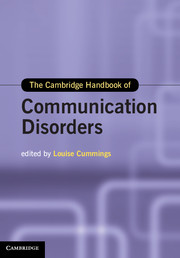Crossref Citations
This Book has been
cited by the following publications. This list is generated based on data provided by Crossref.
Andrade-Miranda, Gustavo
Stylianou, Yannis
Deliyski, Dimitar D.
Godino-Llorente, Juan Ignacio
and
Henrich Bernardoni, Nathalie
2020.
Laryngeal Image Processing of Vocal Folds Motion.
Applied Sciences,
Vol. 10,
Issue. 5,
p.
1556.
De Fina, Anna
and
Georgakopoulou, Alexandra
2020.
The Cambridge Handbook of Discourse Studies.
Ahmadian, Mohammad Javad
and
Long, Michael H.
2021.
The Cambridge Handbook of Task-Based Language Teaching.
de la Torre Carril, Alba
Durán-Bouza, Montserrat
and
Pérez-Pereira, Miguel
2021.
Capacity of the CCC-2 to Discriminate ASD from Other Neurodevelopmental Disorders.
Children,
Vol. 8,
Issue. 8,
p.
640.
Ryding, Karin
and
Wilmsen, David
2021.
The Cambridge Handbook of Arabic Linguistics.
Ayres-Bennett, Wendy
and
Bellamy, John
2021.
The Cambridge Handbook of Language Standardization.
Alduais, Ahmed
Majorano, Marinella
Andrés‐Roqueta, Clara
Hamaguchi, Patricia
Persici, Valentina
and
Qasem, Fawaz
2022.
Conceptualizing, defining, and assessing pragmatic language impairment in clinical settings: A scoping review.
Infant and Child Development,
Vol. 31,
Issue. 6,
Chandler, Jennifer A.
Van der Loos, Kiah I.
Boehnke, Susan
Beaudry, Jonas S.
Buchman, Daniel Z.
and
Illes, Judy
2022.
Brain Computer Interfaces and Communication Disabilities: Ethical, Legal, and Social Aspects of Decoding Speech From the Brain.
Frontiers in Human Neuroscience,
Vol. 16,
Issue. ,
Alduais, Ahmed
Bastianello, Tamara
Alduais, Abdullah
Wu, Xiaoyan Ivy
Qasem, Fawaz
Hamaguchi, Patricia
and
Majorano, Marinella
2025.
Competing views on interventions for pragmatic language skills in persons with pragmatic language impairment: An umbrella review.
Applied Neuropsychology: Child,
Vol. 14,
Issue. 2,
p.
264.



